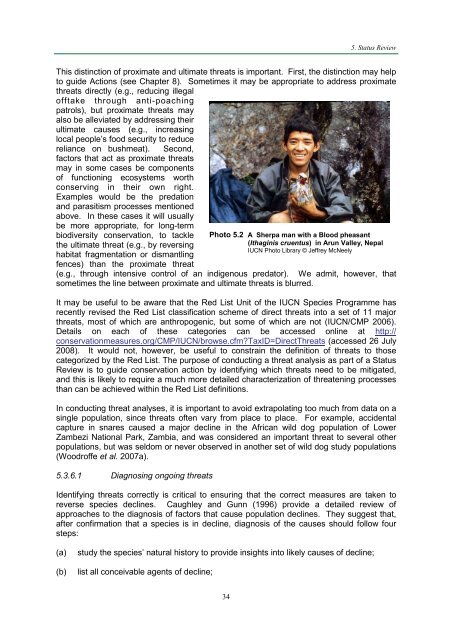Strategic Planning for Species Conservation: A Handbook - IUCN
Strategic Planning for Species Conservation: A Handbook - IUCN
Strategic Planning for Species Conservation: A Handbook - IUCN
You also want an ePaper? Increase the reach of your titles
YUMPU automatically turns print PDFs into web optimized ePapers that Google loves.
34<br />
5. Status Review<br />
This distinction of proximate and ultimate threats is important. First, the distinction may help<br />
to guide Actions (see Chapter 8). Sometimes it may be appropriate to address proximate<br />
threats directly (e.g., reducing illegal<br />
offtake through anti-poaching<br />
patrols), but proximate threats may<br />
also be alleviated by addressing their<br />
ultimate causes (e.g., increasing<br />
local people’s food security to reduce<br />
reliance on bushmeat). Second,<br />
factors that act as proximate threats<br />
may in some cases be components<br />
of functioning ecosystems worth<br />
conserving in their own right.<br />
Examples would be the predation<br />
and parasitism processes mentioned<br />
above. In these cases it will usually<br />
be more appropriate, <strong>for</strong> long-term<br />
biodiversity conservation, to tackle<br />
the ultimate threat (e.g., by reversing<br />
habitat fragmentation or dismantling<br />
fences) than the proximate threat<br />
(e.g., through intensive control of an indigenous predator). We admit, however, that<br />
sometimes the line between proximate and ultimate threats is blurred.<br />
It may be useful to be aware that the Red List Unit of the <strong>IUCN</strong> <strong>Species</strong> Programme has<br />
recently revised the Red List classification scheme of direct threats into a set of 11 major<br />
threats, most of which are anthropogenic, but some of which are not (<strong>IUCN</strong>/CMP 2006).<br />
Details on each of these categories can be accessed online at http://<br />
conservationmeasures.org/CMP/<strong>IUCN</strong>/browse.cfm?TaxID=DirectThreats (accessed 26 July<br />
2008). It would not, however, be useful to constrain the definition of threats to those<br />
categorized by the Red List. The purpose of conducting a threat analysis as part of a Status<br />
Review is to guide conservation action by identifying which threats need to be mitigated,<br />
and this is likely to require a much more detailed characterization of threatening processes<br />
than can be achieved within the Red List definitions.<br />
In conducting threat analyses, it is important to avoid extrapolating too much from data on a<br />
single population, since threats often vary from place to place. For example, accidental<br />
capture in snares caused a major decline in the African wild dog population of Lower<br />
Zambezi National Park, Zambia, and was considered an important threat to several other<br />
populations, but was seldom or never observed in another set of wild dog study populations<br />
(Woodroffe et al. 2007a).<br />
5.3.6.1 Diagnosing ongoing threats<br />
Identifying threats correctly is critical to ensuring that the correct measures are taken to<br />
reverse species declines. Caughley and Gunn (1996) provide a detailed review of<br />
approaches to the diagnosis of factors that cause population declines. They suggest that,<br />
after confirmation that a species is in decline, diagnosis of the causes should follow four<br />
steps:<br />
(a) study the species’ natural history to provide insights into likely causes of decline;<br />
(b) list all conceivable agents of decline;<br />
Photo 5.2 A Sherpa man with a Blood pheasant<br />
(Ithaginis cruentus) in Arun Valley, Nepal<br />
<strong>IUCN</strong> Photo Library © Jeffrey McNeely

















